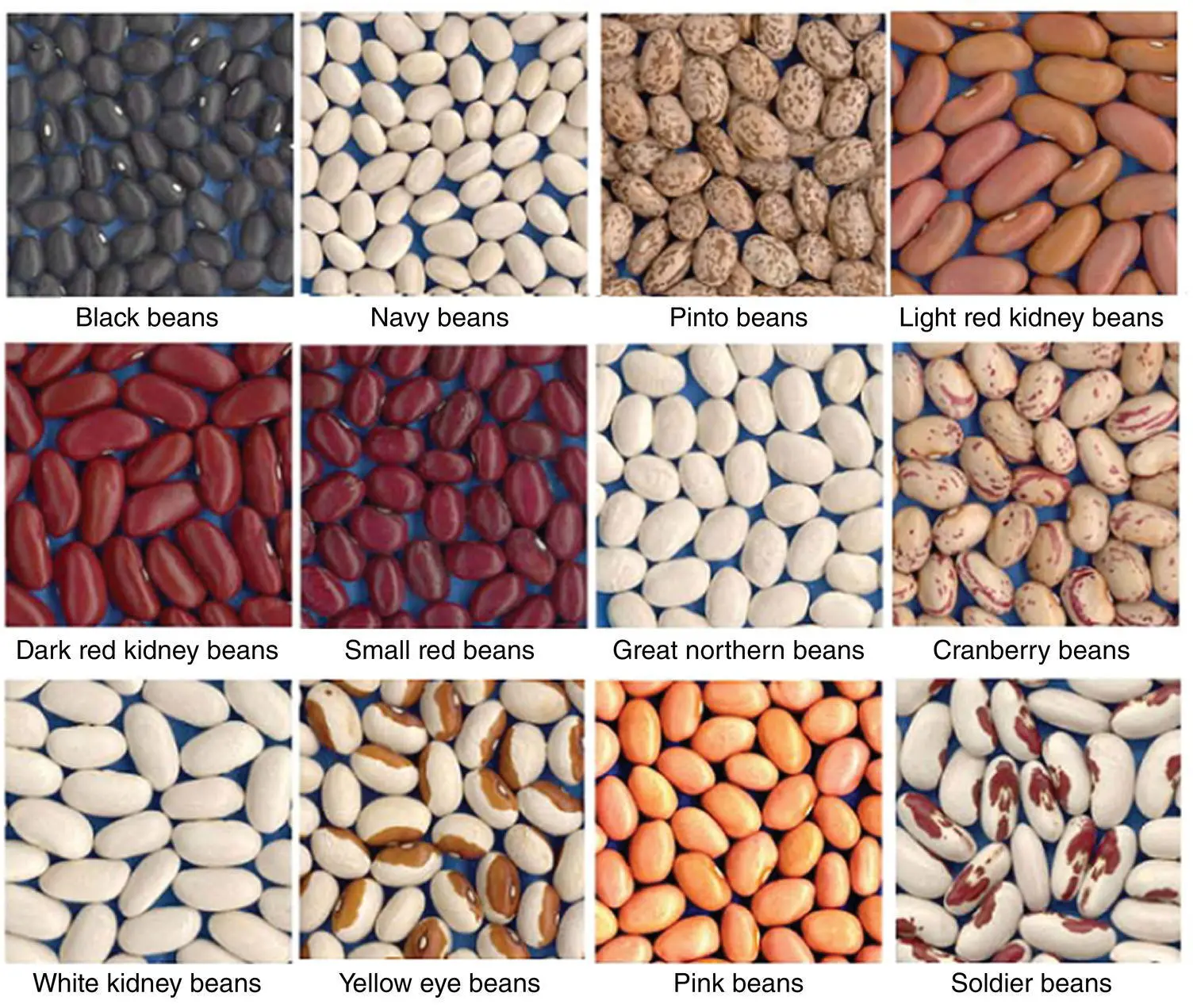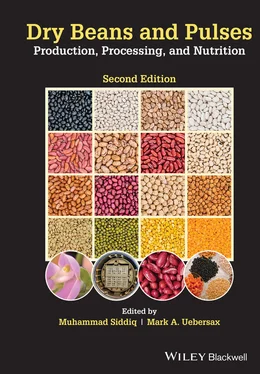Legumes have a very well‐defined botanical classification of specific traits; however, the term legume appears to have a broad connotation when used in commercial trade or by consumers (Azani et al. 2017). Thus, the terminology used for describing leguminous plant products is rather complex and ambiguous. Key elements associated with dry bean and legume terminology are presented in Box 3.1 . This outlined discussion is provided to assist the reader with an understanding of the broad nuances commonly associated with legume terminology.
Box 3.1. Terminology frequently used in conjunction with common beans and legumes.
Phaseolus [mainly common bean (Phaseolus vulgaris L.), but other Phaseolus spp. as well, is the most important pulse crop worldwide.
Legume is derived from the Latin term Legumen, defining seeds harvested in pods or from the Latin term legere, to gather.
Legume seeds possessing low levels of lipids are frequently termed “pulses” and are derived from the Latin puls, referring to pottage, thick soup, or potage.
“Food legumes” (used for direct edible portions, such as beans) versus “forage legumes” (used for crop rotation or animal feed such as clover or alfalfa).
“Legume” was used in early England to encompass all general vegetables in a manner similar to the current French terminology.
“Leguminous comestible” is used to refer to a broad host of edible plant products that may include cereal grains and is thus not limited to the technical and botanical definition of legumes.
“Grain legumes” is commonly used in literature associated with lesser developed regions and subsistence agriculture. (India commonly utilizes this terminology to describe a broad array of crops including soya, chickpeas, dry beans, and lentils.) Grain legumes may be used as edible whole seeds or processed as de‐husked and split cotyledons referred to as dhal or milled into flours and meals.
Various other common food legumes are frequently not distinguished from common bean including soybean (Glycine max (L.) Merr.); cowpea (Vigna sinensis L.); broad/faba/horse bean (Vicia faba L.); garbanzo/chickpea (Cicer arietinum L.); lima bean (Phaseolus lunatus L.); peanuts (Arachis hypogaea); and lentils (Lens culinaris M.).
The United Nations Food and Agricultural Organization (FAO) generally uses the term “legume” to refer to all leguminous plants. The seeds are classified into groups according to the various lipid contents. Thus, terms “pulses” (low‐fat: beans, lentils, chickpeas) and “leguminous oil seeds” (high‐fat: soy and peanuts) are widely accepted.
FAO defines pulses as annual leguminous crops yielding 1–12 grains or seeds of variable size, shape and color within a pod.
Further, the FAO uses the term “pulses” for legume crops harvested solely for the dry grain. Thus, pulses exclude green beans and green peas, which are considered vegetable crops. The term also excludes crops that are mainly grown for oil extraction (oilseeds like soybeans and peanuts), and crops that are used exclusively for sowing (clovers, alfalfa).
Legumes presented in the genus Phaseolus contain only legumes of New‐World botanical origin.
The United Nations General Assembly declared 2016 as the International year of the Pulses (UN 2013).
Pulse grains are an excellent source of protein, carbohydrates, dietary fiber, vitamins, minerals, and phytochemicals (Singh 2017).
COMMERCIAL MARKET CLASSES OF COMMON BEANS
The physical characteristics of the main commercial classes of common beans ( P. vulgaris L.) are presented in Table 3.1 . Twelve different market classes of common beans are recognized in the United States. Although similar botanically, color, size, and shape vary widely among classes ( Figure 3.3 ). Production areas for the major commercial market classes of common beans grown in the United States are presented graphically in Figure 2.1in Chapter 2. These market classes include: (1) navy, (2) cranberry, (3) dark red kidney, (4) light red kidney, (5) pinto, (6) black (black turtle soup), (7) great northern, (8) small red (Mexican red beans), (9) pink, (10) yellow‐eye, (11) small white, and (12) yellow (Peruvian, canary, and Mexican yellow bean). In addition, there are some minor/speciality types of beans available in the marketplace. General descriptions and culinary uses of the different market classes, as described by the Michigan Bean Commission, are summarized below (MBC 2020):
Table 3.1. Physical characteristics and selected cultivars of common dry beans.
Source: Hosfield et al. (2004), Kelly et al. (1999, 2006, 2009), Navabi (2013), Osorno et al. (2009, 2013, 2018, 2020), Uebersax (1989, 1991), Urrea et al. (2009).
| Commercial market class |
Nominal size |
100‐seed wt (g) |
Physical description |
Typical culivars 1 |
| White: |
|
|
|
|
| Navy (pea bean) |
Small |
17–20 |
White seed coat and hilum, ovate to ellipsoidal |
Medalist, Vista, Blizzard, Bounty, Amada, Apex |
| Great northern |
Large |
32–40 |
Oblong and cylindrical, white seed coat and hilum |
Matterhorn, Coyne, Orion, Beryl |
| Small white |
Small |
15–16 |
White seedcoat oblong to flattened |
California, Aurora |
| White kidney |
Large |
50–60 |
White‐cream color with matte finish |
Beluga, Whitetail |
| Solid‐Colored: |
|
|
|
|
| Black (turtle soup) |
Medium |
16–19 |
Glossy black seedcoat with white hilum, ovate to ellipsoidal |
Eclipse, Zorro, T‐39, Shania, Loreto, Black Velvet, Black Bear, Black Tails, Ace |
| Kidney (light or dark red) |
Large |
50–60 |
Light to dark red seedcoat with white hilum, kidney shaped |
Montcalm, Redhawk, Chaparral, Epic, Chinook, CELRK, Pink Panther, Clouseau, Red Zone, Big Red |
| Pink |
Medium |
32–36 |
Solid pale pink seed coat, oblong ellipsoidal to flattened, white hilum |
Sedona, Pink Floyd |
| Small red |
Medium |
32–36 |
Solid deep dark‐red brown seed coat; oblong to flattened, white hilum |
Merlot, Rio Rojo |
| Yellow |
Medium |
26–45 |
Light to dark yellow seed coat; oblong to flattened |
Enola, Canario 707, Mayasi, Al Pimore |
| Mottled/Spotted: |
|
|
|
|
| Cranberry (October) |
Large |
45–58 |
Red mottled on beige background, darkens with storage, oblong with broad width |
Michigan Improved, Taylor, Capri, Etna, SVM Taylor, Dolly, Hooter, Scotty |
| Pinto Slow‐darkening pinto |
Large |
36–42 |
Brown mottled on beige background, darkens with storage, oblong to flattened It takes longer to darken with storage |
Othello, La Paz, Windbreaker, Monterrey, DR Wood Vibrant, Radiant, Lumen, Gleam, ND‐Palomino, Staybright |
| Yellow eye |
Large |
45–55 |
White background with yellow highlights around hilum |
Stuben |
1Current predominate cultivars produced in North America

Fig. 3.3. Pictures of selected common dry beans. (For color detail, please see color plate section.)
Source: MBC (2020a).
Читать дальше













